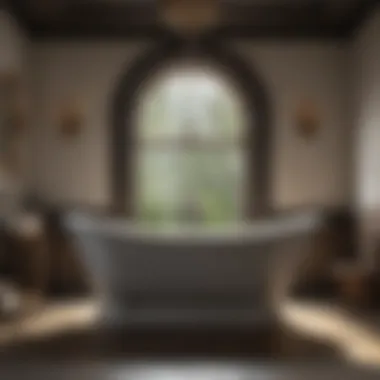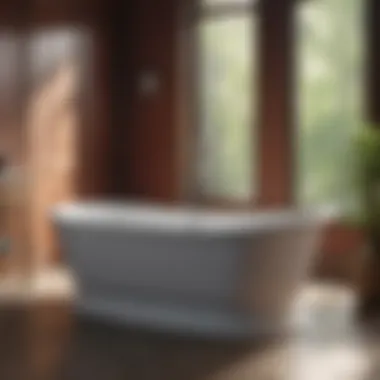Cast Iron vs Acrylic Bathtubs: In-Depth Comparison


Intro
The process of selecting a bathtub can often be daunting. With various materials available, two options frequently emerge as frontrunners: cast iron and acrylic. Each material brings unique characteristics, sometimes making it challenging for house owners and design enthusiasts to determine which one is better suited to their preferences. This guide explores these materials comprehensively, focusing on their differences, advantages, and disadvantages. By diving into aspects such as durability, maintenance, aesthetic appeal, thermal insulation, environmental impact, installation, and cost, this discussion aims to provide valuable insights. Ultimately, it assists consumers in making informed decisions when narrowing down their choices.
Design Inspirations
In the realm of bathtub aesthetics, the choice between cast iron and acrylic can drastically impact a bathroom's design. Here, we explore design inspirations that align with both materials, offering homeowners ideas to create spaces that reflect their personal tastes.
Modern vs. Traditional Bath and Bedroom Styles
Cast iron bathtubs typically channel a nostalgic allure, often associated with traditional designs. They tend to evoke vintage elegance, complementing classic bathroom elements such as clawfoot styles or ornate fixtures. Their robust appearance signifies a return to historic craftsmanship. In contrast, acrylic bathtubs shine in modern settings. They offer sleek lines and versatile shapes, often lending themselves better to minimalist or contemporary themes. Acrylic’s adaptability allows it to seamlessly integrate with various design aesthetics, whether that be bold, geometric forms or soft, organic curves.
Color Palettes and Textures
The color and texture choices for bathtubs can also create distinctive atmospheres in the bathroom.
- Cast Iron: Available in deep hues such as dark green, navy, or black, these bathtubs often come with a glossy enamel finish that adds a sophisticated touch. The heavy, solid texture promotes a sense of stability.
- Acrylic: Offers an array of bright and pastel colors, making it ideal for creating cheerful, inviting spaces. The smooth, lightweight surface is easy to clean and maintain, providing a modern feel.
It is essential for homeowners to consider how their bathtub choice fits into the larger design context of their bath and bedroom. Choosing a bathtub is not solely about functionality; it is about crafting an experience that resonates with personal style.
"A bathtub's material can change the feel of a bathroom entirely, influencing both its look and ambiance."
Product Reviews
In evaluating cast iron and acrylic bathtubs, product reviews emphasize their real-world performance, customer satisfaction, and functional capacities.
Bathtubs and Showers
When discussing specific bathtubs, it is appropriate to highlight leading models.
- Cast Iron Models: The Kohler Iron Works cast iron tub is known for its durability and vintage style. It supports various bathing styles and is available in custom colors.
- Acrylic Models: The American Standard Colony tub is lightweight and designed for easy installation, making it highly appealing for homeowner projects.
Vanity and Sink Options
Choosing bath-related products also extends to vanities and sinks. Cast iron sinks often carry the same robust, classic design as the bathtubs, while acrylic panel sinks are versatile and efficient, complementing modern designs effectively. Both selections influence the visual cohesion of the bathroom, guiding overall design decisions.
Preamble to Bathtub Materials
When selecting a bathtub, the material plays a crucial role in determining the overall performance and aesthetic of the bath space. This article sheds light on the varieties of bathtub materials available, predominantly focusing on cast iron and acrylic. Understanding these materials is essential because it impacts various factors, including durability, maintenance, design possibilities, and cost. This section aims to frame the importance of material selection and provide a broad view of the bathtub types that will be covered in detail.


Overview of Bathtub Types
Bathtubs come in various forms, each tailored for different needs and preferences. The most common types include:
- Cast Iron: Known for durability and heat retention, cast iron bathtubs are often heavy and require robust support. They offer a classic look, appealing to traditional designs.
- Acrylic: Lightweight and versatile, acrylic bathtubs are easier to install and maintain. They come in a range of shapes and colors, making them a flexible choice for modern designs.
- Fiberglass: Similar to acrylic in terms of weight, fiberglass bathtubs are relatively budget-friendly but may not offer the same longevity.
- Stone Resin: This material provides a luxurious feel and impressive durability, though it often carries a higher price tag.
Each type presents unique benefits and drawbacks that cater to different homeowner needs. A clear understanding of these can guide the selection process.
Importance of Material Selection
Choosing the right bathtub material can significantly affect the bathing experience and the bathroom's overall appearance. Here are some key considerations:
- Durability: Different materials possess varying levels of endurance against wear and tear. Cast iron, for instance, can withstand significant impacts, while acrylic may be more susceptible to scratches.
- Maintenance: The care required for each material plays a vital role. Cast iron can demand more attention to preserve its finish, while acrylic generally requires less upkeep.
- Aesthetic Value: The right material can enhance the bathroom's visual appeal, whether aiming for a rustic charm with cast iron or a sleek minimalism with acrylic.
- Thermal Properties: Bathtub materials differ significantly in heat retention. Cast iron retains heat well, offering a warm soak, while acrylic may cool down faster.
- Cost Consideration: The price point varies widely between materials and can influence decisions based on budget constraints.
"Understanding the unique characteristics of each bathtub material assists homeowners in making informed choices that best reflect their lifestyle and preferences."
By diving into these aspects, the subsequent sections of this article will further analyze both cast iron and acrylic bathtubs in detail, allowing for an informed decision-tailored to individual needs and aesthetics.
Cast Iron Bathtubs
Cast iron bathtubs are known for their robust construction and traditional charm. Their significant weight and inherent strength make them a popular option for many homeowners. While not as widely used as lighter materials, they offer unique benefits that can make them the ideal choice for specific settings. Understanding their characteristics is essential for making informed decisions in bathroom design.
Material Composition
Cast iron bathtubs are made from iron, which is then coated with enamel for a smooth, glossy finish. This enamel layer not only provides an attractive look but also protects against rust and corrosion. The thickness of the iron contributes to the bathtub's heavy weight and adds to its durability. This composition allows for a classic aesthetic that appeals to many who prefer traditional home design.
Durability and Longevity
One of the most significant advantages of cast iron bathtubs is their exceptional durability. The inherent strength of cast iron makes these bathtubs resistant to cracking and chipping. With proper care, they can last several decades or even a lifetime. This longevity is especially appealing to those who do not wish to replace their bathtub frequently, saving money and effort in the long run.
Aesthetic Appeal
Cast iron bathtubs exude elegance and sophistication. They often come in various classic designs such as clawfoot, which enhance the visual appeal of any bathroom. The enamel finish can be customized in numerous colors, offering homeowners the flexibility to match their decor. The timeless look of cast iron can elevate the overall style of a bathroom, making it an attractive centerpiece.
Thermal Properties
Cast iron has excellent thermal properties, providing effective heat retention. This means that the water in a cast iron bathtub remains warm for a longer period compared to other materials. For individuals who enjoy long baths, this characteristic enhances the overall bathing experience. A warm bath can contribute to relaxation and comfort, making it an appealing option for self-care routines.
Maintenance Considerations


Caring for a cast iron bathtub involves regular cleaning with non-abrasive products to maintain the enamel finish. While the material is resistant to wear, any chips in the enamel should be addressed promptly, as they can lead to rust. Re-glazing may be required over time to restore the bathtub's shine and protect it from damage. Overall, maintenance is manageable, but it does require attention.
Installation Process
The installation of cast iron bathtubs can be more complex due to their weight. Proper support is crucial to prevent any structural issues. It is often advisable to hire professional installers who understand the requirements for safely placing these heavy fixtures. While the process might take more time and effort, the final result can justify the extra work with stunning aesthetics and performance.
Cost Implications
Cast iron bathtubs typically fall on the higher end of the price spectrum, reflecting their materials and craftsmanship. However, considering their durability and longevity, they can be viewed as a wise investment. Homeowners may find that the initial expense balances out over time due to lowered replacement costs. When budgeting, it is essential to account for installation and maintenance costs, as these can significantly affect the overall expenditure.
Acrylic Bathtubs
Acrylic bathtubs are gaining momentum among homeowners and designers for various reasons. Firstly, the versatility in design and color options allows it to fit into diverse bathroom aesthetics. Moreover, the lightweight nature of acrylic makes it easier to handle during installation, which is a significant advantage for many. Additionally, the material offers impressive insulation properties, which can enhance the overall bathing experience.
Material Composition
Acrylic bath tubs are primarily composed of a mixture of acrylic and other materials, often reinforced with fiberglass for added strength. The combination provides a smooth, non-porous surface that is both visually appealing and practical. This unique composition contributes to the durability of acrylic bathtubs, ensuring they resist chips and scratches better than some other materials. Furthermore, the non-porous nature helps to prevent mold and mildew growth, making them more hygienic and easier to clean.
Durability Compared to Cast Iron
When evaluating durability, acrylic may not seem as robust as cast iron at first glance. However, it holds its own in essential aspects. While cast iron is known for its long-lasting quality and resistance to wear, acrylic bathtubs are less susceptible to chipping and cracking. They can withstand everyday use quite well, especially when maintained properly. However, it is essential to note that heavy items or sharp objects can still damage the acrylic surface. Therefore, care should be taken to mitigate potential harm.
Aesthetic Innovation
A significant draw of acrylic bathtubs is their aesthetic potential. They come in various shapes, sizes, and colors, opening up a world of design possibilities. Unlike the traditional finishes of cast iron, acrylic can be molded and designed to fit modern artistic themes. This flexibility allows homeowners to pick a tub that aligns with their vision for the bathroom, whether aiming for sleek lines or bold colors. The glossy finish further enhances the bath's visual appeal, reflecting light and giving the space an open feel.
Thermal Insulation Characteristics
Thermal insulation is another advantage of acrylic bathtubs. The material retains heat better than some other options, creating a more pleasant bathing experience. This means that the water remains warm for an extended period, reducing the need to refill the tub during a relaxing soak. This characteristic is particularly beneficial in colder climates, as it enhances comfort.
Maintenance and Care
In terms of maintenance, acrylic bathtubs are relatively simple to keep in good shape. Regular cleaning with non-abrasive products keeps the surface looking fresh and shiny. Stains can often be wiped away easily without the need for harsh chemicals. However, homeowners should avoid using abrasive cleaners or scrubbers, as they can harm the surface. A gentle sponge or cloth works well for routine care.
Ease of Installation
Installation of acrylic bathtubs is generally straightforward, primarily due to their lighter weight compared to cast iron. This ease of handling can reduce installation-related challenges, allowing for faster completion. Additionally, many lightweight options are available, making it easy to position and adjust as necessitated by the layout of the space. Thus, if a homeowner plans a DIY project or requires quick installation, acrylic may be the preferred choice.
Budget Considerations


Finally, budget considerations play a crucial role in the decision-making process. Acrylic bathtubs tend to be more affordable than their cast iron counterparts. This lower price point allows homeowners to balance quality and cost-effectiveness. However, it’s important to consider long-term costs, such as maintenance, because while initial prices may be lower, upkeep could incur expenses.
Generally, acrylic bathtubs offer both a cost-effective and versatile option for modern bathrooms.
In summary, acrylic bathtubs present an array of advantages for those looking for style, comfort, and convenience. This material provides options that cater to varying tastes while being mindful of practicalities.
Comparison Between Cast Iron and Acrylic
The comparison between cast iron and acrylic bathtubs is pivotal in understanding which material best serves a homeowner's unique needs. Both options present distinct characteristics that cater to different preferences, budgets, and lifestyles. By examining factors such as weight, resale value, environmental impact, and user experience, homeowners can arrive at an informed conclusion that aligns with their long-term goals.
Weight and Structural Support
One of the most significant factors to consider is the weight of the bathtubs. Cast iron bathtubs are known for their substantial weight, often exceeding 300 pounds. This inherent mass requires robust structural support during installation. Homeowners must ensure their bathroom floors can withstand this weight to avoid future issues. On the other hand, acrylic bathtubs are significantly lighter, typically weighing between 50 to 100 pounds. This lighter weight enables easier handling and installation, making it a suitable option for those who may not have the same structural considerations as cast iron.
Resale Value Considerations
When it comes to resale value, the choice between cast iron and acrylic can influence property appraisal. Cast iron bathtubs are often viewed as a luxury feature due to their durability and timeless appeal. Many potential buyers appreciate the elegance of a cast iron tub, which can lead to a higher resale value. In contrast, while acrylic bathtubs are generally more affordable, they might not hold value in the same way. Their lifespan is typically shorter, which could deter buyers looking for long-lasting fixtures in their new home.
Environmental Impact
The environmental impact of bathtub materials is an emerging consideration for many homeowners. Cast iron bathtubs are made from natural materials, which can be more sustainable than acrylic, produced from petroleum-based products. However, the manufacturing process of cast iron requires significant energy. Acrylic bathtubs may have a larger initial ecological footprint, but their lighter weight often results in lower transportation emissions. Homeowners who prioritize eco-friendliness should weigh these factors carefully.
User Experience and Comfort
User experience is ultimately the essence of why homeowners select a bathtub. Cast iron bathtubs provide a luxurious bathing experience. The material retains heat exceptionally well, leading to warmer baths that enhance comfort. This feature is particularly appealing during colder months. Conversely, acrylic bathtubs can be less effective in heat retention, but modern technology has improved their thermal characteristics to an extent. Additionally, acrylic can be molded into various shapes and sizes, catering to different preferences, ensuring that users find a suitable option for their space.
Final Thoughts
Determining the Right Choice for You
When it comes to selecting the ideal bathtub, personal needs should take precedence. For families with young children, the durability and weight of cast iron might be appealing, as it resists scratches and may hold up better under daily use. On the other hand, someone who prefers easy installation and lower weight may lean towards an acrylic option. It is crucial to factor in future intentions as well; for instance, if reselling a home, investing in a cast iron tub might improve property appeal. Furthermore, aesthetic preferences also play a role; some individuals may appreciate the classic look of cast iron, while others find the versatility of acrylic more in line with contemporary design.
- Think about usage frequency.
- Consider the demographic of occupants.
- Weigh environmental impact and efficiency.
Concluding Recommendations
In summary, both cast iron and acrylic bathtubs have their rightful place in modern bathrooms. Here are a few last thoughts to guide your decision:
- Cast Iron: Strongly recommended for long-term investment and traditional appeal. Ideal for users who value durability and a classic look.
- Acrylic: Suitable for those who seek variety and easy maintenance. Often a better option for those on a budget or looking to remodel with less hassle.
Consider the factors that mean the most to you: durability, safety, style, or maintenance. It is advisable to visit showrooms and experience the materials firsthand before making a final choice. This small step can greatly influence satisfaction with your final decision. Remember, the right bathtub serves not just as a fixture but as a reflection of your home and lifestyle.
"Choosing the right bathtub transforms a mere bathroom routine into a delightful experience."
Prioritize what resonates with your needs, and make an informed decision that aligns with your goals.















